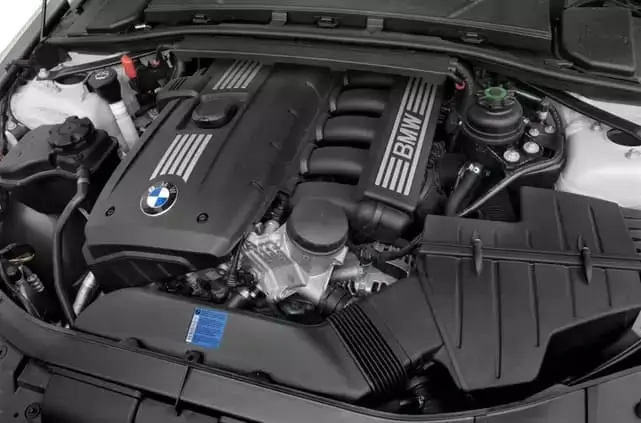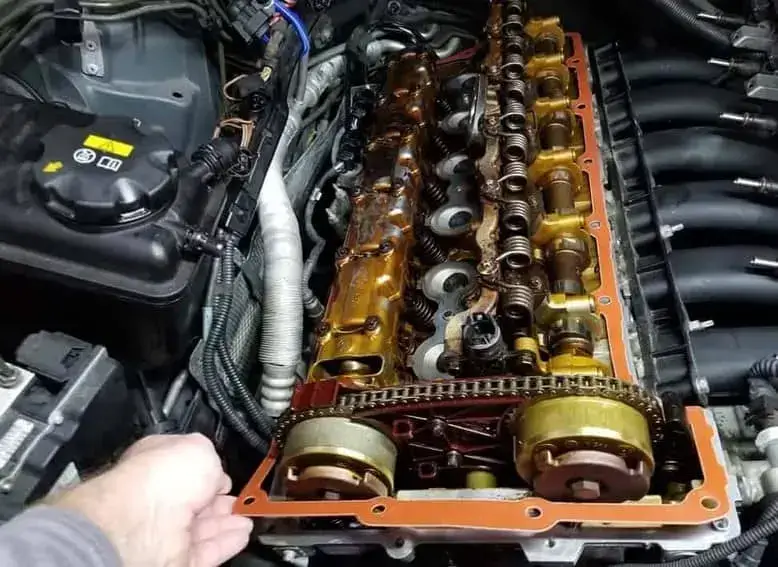The N52 is a 6-cylinder naturally aspirated engine that replaced the M54 engine and became one of the most successful and reliable BMW engines of all time.
With production between 2004 and 2015, BMW brought an almost identical brother engine onto the market: the N51 engine. With a few differences, the almost identical N51 and N52 produce the same power.
Let’s learn more about the BMW N51 engine in this blog.
BMW N51 engine overview
The N51 engine is a slightly modified variant of the N52 that meets SULEV standards. Sold primarily in some parts of the US with implemented SULEV regulations.
So let’s talk a few things about the N52, which laid the foundation for the N51 engine. The N52 is a 6-cylinder naturally aspirated engine that was produced in various BMW models from 2004 to 2015. It was the first water-cooled engine whose engine block construction consisted of a magnesium/aluminum composite material.
The N52 was also included in the Ward’s Top 10 Engines list in 2006 and 2007. So you could say that the N52 already has a pretty big legacy in BMW’s engine lineup.
Then the N51 comes with an improved three-stage variable length intake manifold (DISA) and much more, which we’ll cover in the Differences section.
I have many friends who now know the true value of this engine and still regret selling their N51 engine.
BMW N51 VS N52
Basically, the N51 and N52 are the same engine, or you could say they are almost identical siblings. However, there are some differences in both N51 and N52 that draw the line between them.
For example, the N51 has a three-stage variable-length intake manifold, while the N52 has a single-stage one. It also results in a lower compression ratio of 10.0:1 instead of N52’s 10.7:1.
The N51 also features an advanced “Prem-Air” coating cooler with an integrated EAC (Environmental Air Catalyst) sensor. This measures the radiator functions. Both also have a different cylinder head and combustion chamber design.
These are some of the basic differences between N51 and N52. It is not possible to visually distinguish between the two engines. To do this you need to look for the emissions label on the hood where it says ULEV (N52) and SULEV (N51).
For detailed difference between N51 and N52 visit here: BMW N51 vs. N52: Differences you should know
The most common problems with the BMW N51 engine
As any enthusiast may know, the N51 is a very reliable engine. However, like any mechanical engine, the N51 is not prone to some problems. The N51 also has the same common problems as its sister model, the N52.
VANOS error
Like the N52 engine, the N51 also uses the variable valve timing system, also known as double VANOS, in the intake and exhaust valves. And like the N52, the N51 is also at risk of VANOS failure.
The VANOS system uses VANOS solenoid valves that control the flow of oil to the actuators to move the cam wheels by opening and closing the valves.
And whenever you drive your car, the VANOS system is activated. Because the system is always activated, the solenoids are susceptible to failure due to wear. If the VANOS system fails, there will be a significant decrease in engine performance, rough idling, poor fuel economy, etc.
To avoid this problem, always change the solenoid valves every 70,000-75,000 miles. It’s not expensive and it’s easy to make yourself.
EAC sensor
The EAC (Environmental Air Catalyst) sensor is attached to the radiator and monitors the function of the radiator. So if this sensor fails, it can cause the emissions or smog test to fail. Even if this sensor is not working properly, you will see a check engine light warning message on your dashboard.
And one of the unfortunate aspects is that if this sensor fails, you will have to replace the entire radiator because this sensor is already attached to the radiator.
Also check: The 8 most common engine problems on the BMW N52
Many of my friends faced a similar problem but got off lightly because the N51 SULEV offers 15 years or 150,000 miles of coverage for all emissions-related issues. (as far as I know)
Problems with the hydraulic valve adjusters (lifters) ticking.

This problem in N51 is similar to that N52 engine problem. Where with higher mileage the N51 hydraulic tappets wear out and cause an annoying ticking noise while driving.
That annoying ticking noise will be pretty constant. The ticking noise is strongest when the engine is cold, but the noise gets slightly better when the engine is warm.
This is a fairly common problem when the hydraulic valve lifters malfunction due to insufficient oil circulation on the lifters. This is essentially due to the cylinder head and poor tappet design, which disrupts proper oil circulation.
Water pump failure
In the N51 and N52, BMW introduced its plastic water pump, a relatively new technology. And as expected, it had a lot of problems and broke down at 40,000 to 45,000 miles.
However, it had many advantages despite being relatively new technology for the manufacturer and being quite poorly built, leading to an early damage problem.
If the water pump is damaged, you will notice that your engine overheats, the radiator fan runs more than usual, sometimes smoke comes out of the radiator, etc.
Thermostat error
This can be another problem that can occur with the N51 like the N52. Often the failure of the thermostat is confused with the failure of the water pump or vice versa. Because both work together to control engine temperature.
There the hot coolant is passed through the radiator to cool down and the cold coolant is then passed back into the engine through the water pump. So you could say they pretty much go hand in hand.
There are two ways the thermostat can fail: either open or closed. If the thermostat fails in the “closed” position, it stops the flow of hot coolant into the radiator. This causes the engine to overheat very quickly and makes your internal engine components very vulnerable to premature wear.
Also check: BMW N52 engine: Everything you need to know
So the main symptoms of a failed thermostat would be engine overheating, coolant leaks, long time to reach normal temperature during cold starts, etc.
Oil filter housing seal leaking
The oil filter gasket seals the oil filter housing in the engine. And if it cracks over time, it can cause oil leaks. It is also a very common problem with the N51/N52 and the entire N5x family.
Therefore, as with any oil leak, it can be very dangerous because it leaks in front of the engine. If ignored, it can cause pretty serious damage to the engine.
Failure to do so could result in complete engine failure or, in the worst case scenario, require thousands of dollars worth of repairs. So if you notice oil leaking from the oil filter housing area, get it fixed quickly.
Valve cover gasket leaking

The Valve cover gasket leak is quite common in many BMW engines.
With constant heat, over time the cover gasket will wear and crack, allowing oil to leak into the engine compartment. You won’t get a warning signal for this, but you may notice a burning oil smell, smoke coming from the valve cover, oil leaks, a low engine oil indicator light, etc.
If you experience this problem, have the gasket replaced quickly and avoid major problems.
These are some of the most common problems that can occur with the N51 engine. These common problems occur in almost all engines, and the N51 does not experience any serious problems.
What is a SULEV engine?
SULEV (Super Ultra Low Emission Vehicle) is an emissions standard introduced by the California Air Resources Board (CARB) for the US classification of passenger vehicle emissions.
The California Legislature proposed manufacturers for a certain percentage of SULEV vehicles, and BMW subsequently introduced the N51 engine. The N51 was designed to produce a compression ratio of 10.0:1 versus 10.7:1 for the N52 engine.
The SULEV is 90% cleaner and emits fewer hydrocarbons, carbon monoxide, nitrogen oxides, etc. than average annual vehicle models. When tested under an FTP-75 cycle, the N51 produces approximately 1.0 g/mi CO (carbon monoxide) and 0.02 g/mi NOx (nitrogen oxides), compared to 2.1 g/mi CO (carbon monoxide) and 0. 07 g/mi NOx (nitrogen oxides) for the N52 engine NOx.
This was a very good level for the environment and the set emission value.
Is the BMW N51 more expensive to buy?
Well, long answer short: Yes, the N51 is quite expensive compared to the N52 engine. There are several valid reasons why the N51 is more expensive, such as: B. several improved expensive components that ensure lower emissions. The use of expensive parts is also quite complicated, which increases the cost.
Added to this are the subsequent purchase costs, as many parts had to be replaced as a whole. For example, if the EAC sensor in the radiator becomes damaged, the entire radiator must be replaced.
Just like the radiator, there are many other parts that need to be replaced due to their complexity and usage as a whole.
However, the N51 or SULEV engines received a relief, namely a 15-year or 150,00-mile warranty. It states: “If an emissions-related part of your vehicle is defective, the part will be repaired or replaced by BMW NA.”
I know some people who have saved a lot of money with the extended warranty. It also depends on your BMW dealer, some dealers don’t know the warranty information.
Diploma
So now you know everything about the N51 engine and to know more about its sibling engine, visit here: BMW N52 engine: Everything you need to know.
Both the N51 and N52 are very good engines with a high level of reliability. However, if you decide to purchase an N51 engine, you must be aware that maintaining the N51 can be quite expensive.
So make your decision carefully. However, if you get good condition, lower mileage and remaining warranty period under the engine then you should go for it. However, the costs will be very high after the warranty expires.
Otherwise, if you don’t have a lot of money, you can always rely on the N52 engine. With the same performance and known reliability, the N52 can also be a good choice.
FAQ
The N51 engine is the SULEV version of the N52 engine with some improved components and the same performance. The N51 is also very reliable with an output of around 240 hp.
Yes, the N51 engines are very good as it is a very reliable engine with a very low level of emissions. The N51 is a SULEV engine with 90% lower emissions.
The N51 SULEV engine produces around 240 hp.
Note: The picture shown shows an N52 engine.
Image source: Cars.com
Similar posts:
BMW N52 engine: Everything you need to know
BMW N52 reliability: The large naturally aspirated engine
What is the oil capacity of the BMW N52?
BMW N52 Oil and Filter Change DIY Guide (Step by Step Guide)
The 8 most common engine problems on the BMW N52
Which BMW models have the N52 engine?
